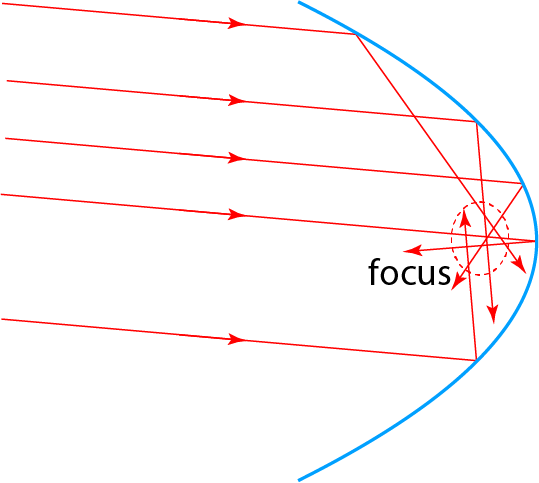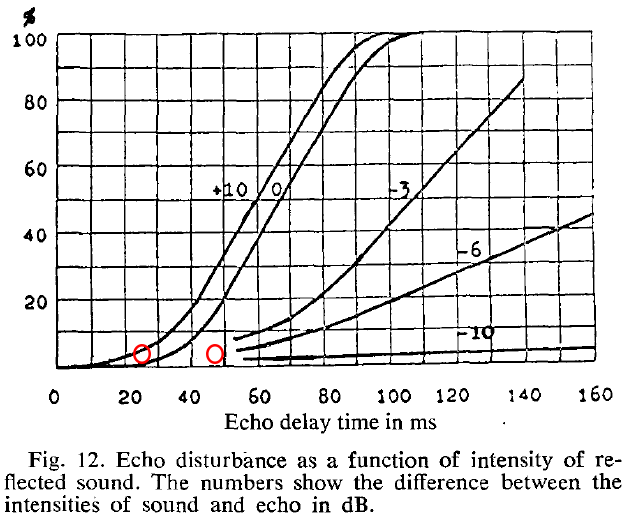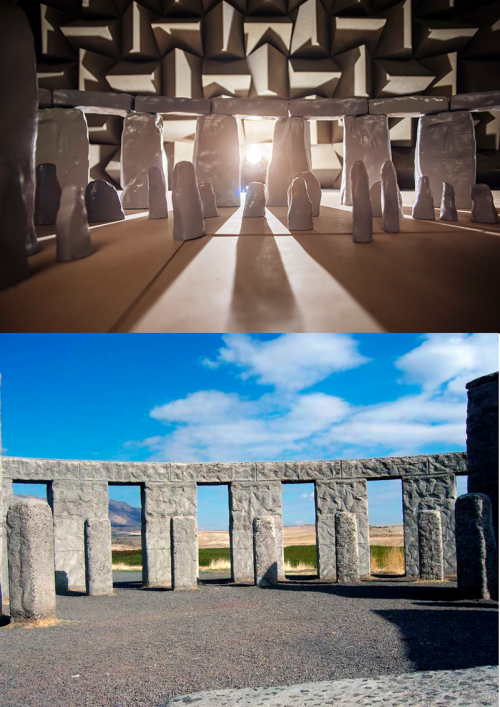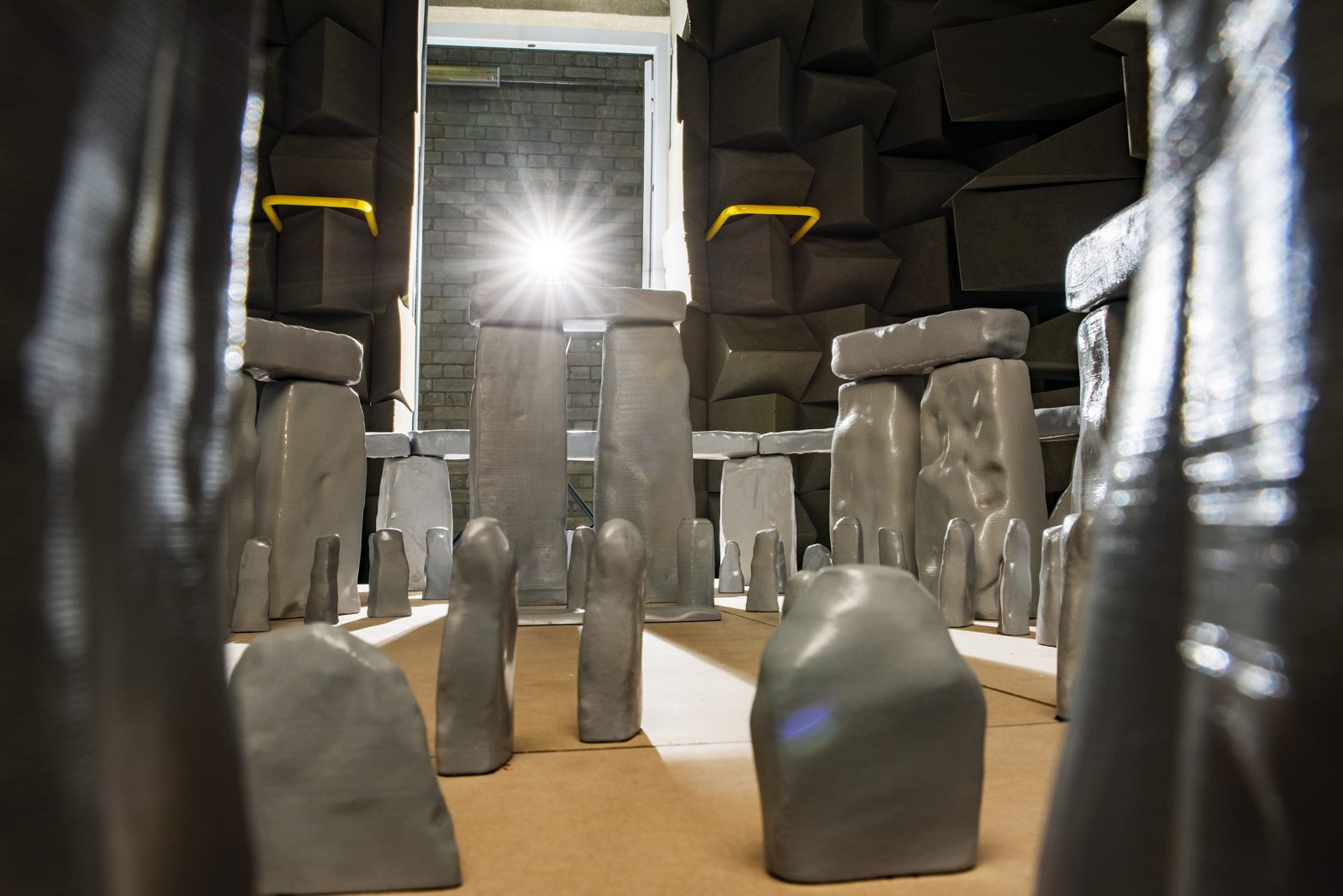Stonehenge is a stone circle, did that create unusual echos?
Large concave surfaces can cause sound to be focussed as Figure 1 shows. This causes sound to be amplified at the focal point, and this can lead to echo effects. The video below is from underneath the dome in the Shah mosque in Isfahan, the ricocheting sounds you hear are focussed reflections from the concave domed ceiling.

Given that the outer sarsens in Stonehenge form a large circle, did they also focus the sound like the dome of the mosque? And did that result in an audible echo?
The term ‘echo’ will be used for any sound reflection which is subjectively noticeable as a distinct repetition of the original sound signal.
Heinrich Kuttruff, Room Acoustics
Previous claims
In a recent paper Till wrote: “The central position in Stonehenge could produce a particularly strong focusing of sound for someone standing there.” [1] Figure 2 is an amalgamation of two figures from that paper. The right image illustrates the focusing mechanism for someone in the centre of the stone circle. The left image shows the impulse response from Till’s computer model ‘Digital Stonehenge.’ This shows the sound you’d pick up on a microphone at the focal point from a short sharp sound (e.g. a balloon burst). The first biggest spike is the sound direct from source to receiver, everything else is reflections from the stones. There are two prominent strong reflections.
![Fig. 2. Response in centre of 'Digital Stonehenge' [1] and the suggested focusing mechanism. Writing in white are additional annotations by myself.](http://trevorcox.me/wp-content/uploads/2020/03/till_paper_echo3.png?w=500)
The implication from the paper is that these strong reflections are due to the focussed reflections from the outer Sarsens, but this is can’t be true. The outer circle in Stonehenge is roughly 30 metres in diameter, which means that any focused reflections from the outer sarsens will arrive about 0.09 seconds after the direct sound. I’ve marked this point with “outer sarsen reflections” to show where this would be in the impulse response. The strong reflections are too early. These are actually from the large inner trilithons (the five structures forming a horseshoe shape in the right of Figure 2).
Would these reflections from the inner trilithons have created an audible echo? These large reflections arrive about 25 and 50 milliseconds after the direct sound. This means they’re unlikely to be audible as separate echoes because they arrive too quickly. For evidence look at Fig. 3, which is a classic measurement by Haas [2]. It shows the % of people who are likely to be disturbed by the presence of a reflection. The different lines represent different levels of reflections. The -3 and -6 lines are the relevant ones here [3], with the red circles being the region of interest for the two strong reflections shown in Figure 2. These reflections are not going to create “echo disturbance.” Reflections at these levels and delays may alter the timbre of a sound, but they don’t cause discrete echoes.

Incidentally, the impulse response in Figure 2 from ‘Digital Stonehenge’ is inaccurate. They don’t look anything like the measured results from the Maryhill Stonehenge replica or my 1:12 physical scale model of Stonehenge.
New analysis using measurements
Two sets of measurements allow us to properly examine whether the 2,200 BC configuration of Stonehenge might have had discrete echoes created by focusing from the outer sarsens:
- Measurements in Salford’s 1:12 physical scale model of Stonehenge.
- Measurements by Fazenda and Till in the Maryhill Stonehenge replica.

The impulse responses for the model and replica are shown in Figure 4. These are for the cases where the source and receiver are close to the centre of circle. Any focused reflections from the outer sarsens should arrive just before 0.1 seconds on the x-axis. There is some evidence for those sort of reflections in the Maryhill replica, but none in the 1:12 physical scale model.

Such differences are to be expected because the model and replica are different as the photos in Figure 5 illustrate. I would expect weaker focusing effects in our scale model compared to Maryhill because:
- The stones are more irregular and amorphous in the scale model, which results in scattering that blurs any focussing.
- There are more bluestones in the scale model. These are also more irregular. Again this promotes more scattering and blurs the focus.
It’s also instructive to look around the 3D image below, which comes from the centre of the scale model. As you look around, particularly behind the initial camera angle, notice how the sarsens that form the outer circle are often hidden by other stones. Only about half of the outer sarsens are clearly visible. Also, the smaller bluestones are actually quite tall and many get in the way. Looking at this, it’s unsurprising that there are no strongly focused reflections from the circle of outer sarsens.
Given that the 1:12 physical scale model is a better representation of the geometry of the stone circle in 2,200 BC, it’s that impulse response we’re going to consider further.
Scale model
While looking at Figure 4 (top) hints there are no echoes, it’s possible to do a more scientific analysis. I’m going to follow the method outlined in Kuttruff [4].

Figure 6 (left column) shows the impulse response for the central position at the top and below the smoothed envelope of the impulse response. The smooth envelope roughly simulates some of the early stages of hearing. What we’re looking for is a prominent bump in the smoothed envelope indicating strong reflections. But there is nothing like that.
To give you a sense of what it would look like if there was an echo, I have edited the impulse response to add a strong reflection at about 0.1 seconds. This is shown in the right column. Now an echo is seen both in the impulse response and the smoothed envelope. Remember, there is nothing like this in any of the 30 measurements we’ve made in the scale model, #FakeEcho, I’ve falsely created an echo to explain the process.
The other way to check for echoes is to listen. Below is an auralisation from the model with a short snippet of speech. (Our current measurements are limited to about 5,500 Hz, which is why it sounds a little dull). First you’ll hear the centre of the Stonehenge model (s1-m1) and no echo is apparent. From the middle of the file about 12 seconds in, you’ll hear my example with #FakeEcho added.
Summary
No evidence of strong focused reflections from the outer sarsen circle is seen in the measurements on the 1:12 physical scale model of Stonehenge. This is unsurprising given the irregular shape of the stones, and the number of other stones that get in the way of any focusing sound. There is no evidence for audible echoes, where a clear repetition of sound is heard. Stonehenge has fascinating acoustics, but it is unlikely that the configuration from 2,200 BC had any notable discrete echoes inside the circle.
References and notes
[1] Till, R., 2019, September. Sound Archaeology: A Study of the Acoustics of Three World Heritage Sites, Spanish Prehistoric Painted Caves, Stonehenge, and Paphos Theatre. In Acoustics (Vol. 1, No. 3, pp. 661-692). Multidisciplinary Digital Publishing Institute.
[2] Haas, H., 1972. The influence of a single echo on the audibility of speech. Journal of the Audio Engineering Society, 20(2), pp.146-159.
[3] I’m assuming the reflections are at about -3 and -6 dB. Unfortunately the original paper has no dB scale on the vertical axis. But the picture is from Adobe Audition, and I’ve used that deduce the likely difference.
[4] H. Kuttruff, Room Acoustics, CRC Press, Section 8.3.
Follow me
5 responses to “Stonehenge, henge, henge”
Hi Trevor,
Great post, as always. Just wondering: we always assume Stonehenge was a totally open air gathering place. What if they had a contingency? Some sort of cloth that could be stretched across the top, possibly fixed into place by stones or tent poles? One would assume there might be some sort of mild reflection then.
Damian
I’m not an archaeologist so hard to comment, but from a purely practical point of view at 30m across it would be quite a challenge to make and anchor.
Hi Trevor I now wonder about acoustics at nearby and connected Durrington Walls. By chance our family discovered an unexpected and loud echo in a natural bowl in a grubbed up orchard (Kent) with wet grass slopes, distant trees and no buildings. Durrington Walls looks like an amphitheater with its steep sides.
Excellent and enlightening archeoacoustic research Trevor!
Any chance you could consider making these impulse responses available to download from this site in the Wave format to use in an IR loader? It’s fascinating to read and hear simulations done by other people with their sounds, but it would be nice to experiment freely with any sounds to see what findings might surface from certain combinations of sounds – or just musical use like Stellar recorded her beautiful album in King’s Chamber, Giza.
I’ve played around with the Maes Howe and Newgrange impulse responses from OpenAir library and Rosslyn Chapel from Scotland Mapping Project. For example I recorded an aum/oum meditation dry and then convolved that with the Newgrange IR that corresponds to the 110hz which would’ve resonated with a priest’s voice in ancient times and then played that in accompaniment with a meditation session of few voluntees to provide them with a backing track to meditate to – it gives you an entire new level of immersion and understanding of how the space would’ve functioned acoustically and augmented ancient rituals!
There’s available on Figshare https://salford.figshare.com/articles/dataset/Stonehenge_impulse_response_measurements/12687554 However, they are only for the analysed octave bands, so they’re not going to work very well in a convolution reverb. I need to do some measurements with a source that goes to a higher frequency, but that isn’t going to happen any time soon.